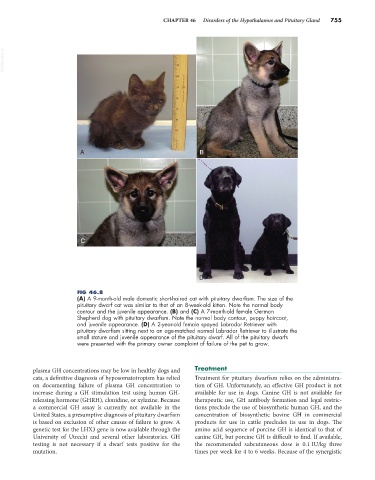Page 783 - Small Animal Internal Medicine, 6th Edition
P. 783
CHAPTER 46 Disorders of the Hypothalamus and Pituitary Gland 755
VetBooks.ir
A B
C
D
FIG 46.8
(A) A 9-month-old male domestic short-haired cat with pituitary dwarfism. The size of the
pituitary dwarf cat was similar to that of an 8-week-old kitten. Note the normal body
contour and the juvenile appearance. (B) and (C) A 7-month-old female German
Shepherd dog with pituitary dwarfism. Note the normal body contour, puppy haircoat,
and juvenile appearance. (D) A 2-year-old female spayed Labrador Retriever with
pituitary dwarfism sitting next to an age-matched normal Labrador Retriever to illustrate the
small stature and juvenile appearance of the pituitary dwarf. All of the pituitary dwarfs
were presented with the primary owner complaint of failure of the pet to grow.
plasma GH concentrations may be low in healthy dogs and Treatment
cats, a definitive diagnosis of hyposomatotropism has relied Treatment for pituitary dwarfism relies on the administra-
on documenting failure of plasma GH concentration to tion of GH. Unfortunately, an effective GH product is not
increase during a GH stimulation test using human GH- available for use in dogs. Canine GH is not available for
releasing hormone (GHRH), clonidine, or xylazine. Because therapeutic use, GH antibody formation and legal restric-
a commercial GH assay is currently not available in the tions preclude the use of biosynthetic human GH, and the
United States, a presumptive diagnosis of pituitary dwarfism concentration of biosynthetic bovine GH in commercial
is based on exclusion of other causes of failure to grow. A products for use in cattle precludes its use in dogs. The
genetic test for the LHX3 gene is now available through the amino acid sequence of porcine GH is identical to that of
University of Utrecht and several other laboratories. GH canine GH, but porcine GH is difficult to find. If available,
testing is not necessary if a dwarf tests positive for the the recommended subcutaneous dose is 0.1 IU/kg three
mutation. times per week for 4 to 6 weeks. Because of the synergistic

